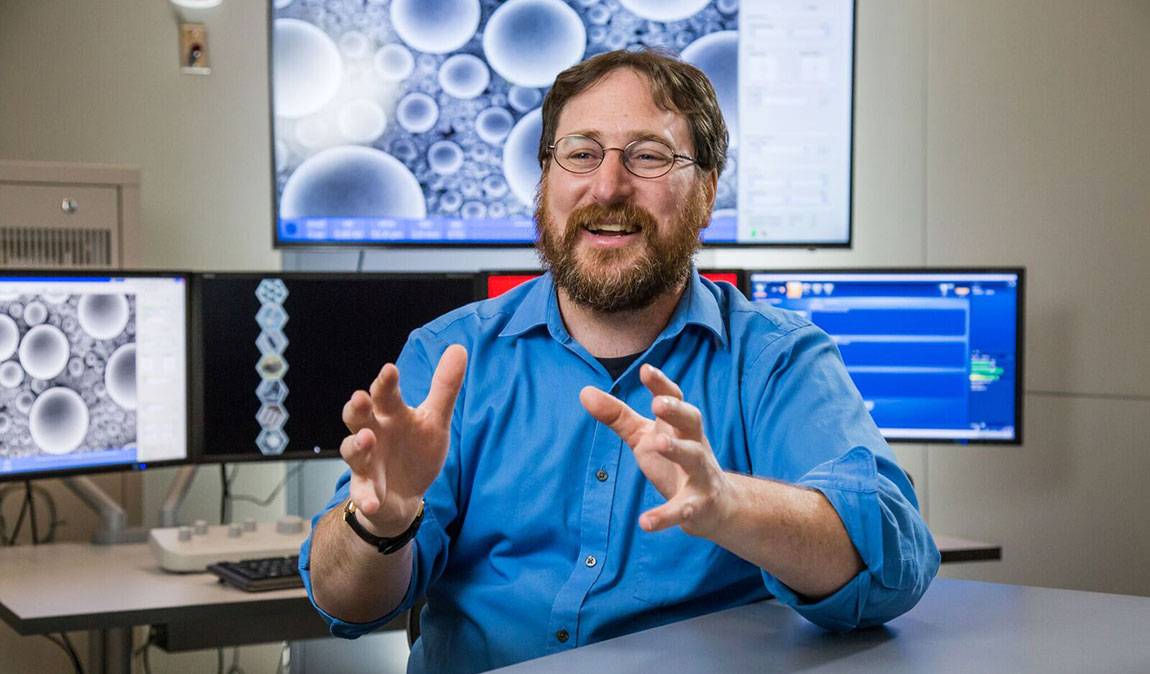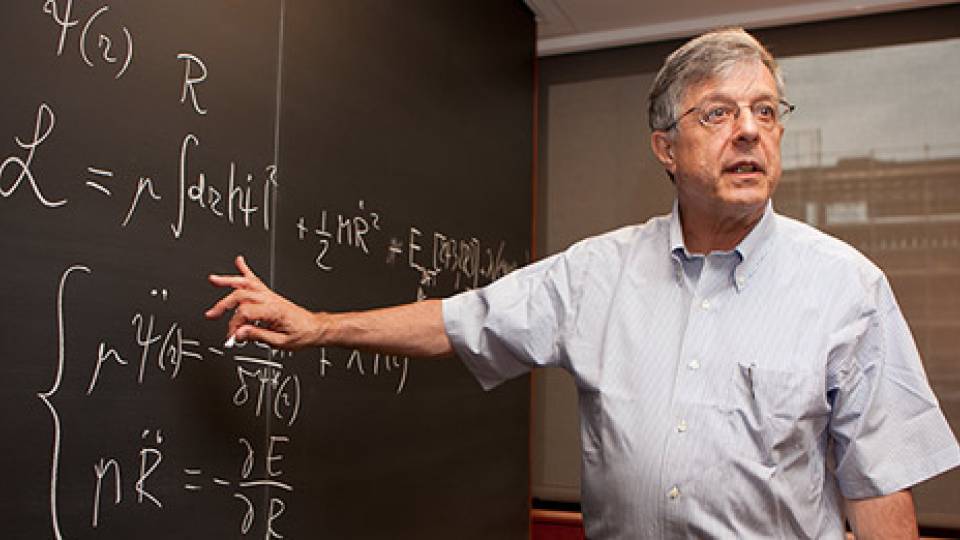Name: Craig Arnold
Title: Professor of Mechanical and Aerospace Engineering; Director of the Princeton Institute for the Science and Technology of Materials (PRISM)
Scholarly and administrative focus: Arnold became director of the Princeton Institute for the Science and Technology of Materials (PRISM) Jan. 1 after serving as interim director since July 2015. The institute recently installed cutting-edge imaging equipment in the new Andlinger Center for Energy and the Environment building, including a microscope that is capable of imaging individual atoms and is one of only four of its kind in the world. In the control room of a new scanning electron microscope, Arnold recently answered questions about materials science and engineering at Princeton.

Craig Arnold (pictured), professor of mechanical and aerospace engineering, became director of the Princeton Institute for the Science and Technology of Materials (PRISM) Jan. 1. Arnold recently discussed his passion for materials science and engineering, and his vision for those fields at Princeton. (Photo by David Kelly Crow)
What is materials science?
Materials science and engineering is the study of the stuff that makes up the world around us. Pretty much everything is composed of materials, whether it is the table that I am sitting at, or the car that you drive, or the computer that you use. What we do is we study these materials, how their atoms are arranged, how to change their properties and how to control their response to certain stimuli. Basically, the study of materials allows us to make new materials with exciting new properties or make the existing ones we have perform better.
What is it about materials science that fascinates you?
The interesting thing about materials science for me is that it brings together traditional disciplines in the natural sciences and engineering and tends to work at the interfaces among them. The joke that I always say is that the greatest thing about being a materials scientist is that it gives me a secret password that gets me into any club that I want. Whether it's chemistry or physics, mechanical or electrical engineering, if you look around, you're bound to find a materials scientist or engineer.
You like to open your classes by mentioning your three favorite materials. What are they?
[laughs] Silicon, steel and pre-stressed concrete. They all are things that require an incredible knowledge of materials science and each has reshaped civilizations. Steel really is the enabling technology that allowed us to become an agrarian society. What is particularly interesting about steel — compared to other forms of metalworking in the early historical period — is that to make steel you need to coordinate many different things. You can't just dig a rock out of the ground and turn it into steel. You needed ore, and you needed trees, and you needed limestone. And you needed trade to get all of these things together. Not only the steel itself, but also the process of making it reshaped civilization. Of course, over the millennia people figured out how to make steel better and we are still doing that today; slight changes of the steel alloy make the difference between razor blades that stay sharp and ones that you have to throw away after few uses.
Silicon, of course, has enabled the development of computers. Everyone thinks it was the transistor that made computers possible. And absolutely it was — the transistor made it possible. But what people don't think about is that what enabled that transistor was the ability to create very pure materials. The semiconductors that you use in a computer, you have to be able to control the amount of impurities to incredibly fine levels. If you can't do that, you can't make a transistor that works. The materials scientists had to figure out how to make silicon really, really pure. That required many years of understanding: how to process materials, how to melt and form materials. Nowadays you can just call up a vendor and you buy a piece of silicon wafer to make a computer chip that has the exact amount of impurities you want in a 12-inch wafer with almost no flaws. This is a remarkable achievement of materials science and it is what allows us to make computers that are cheap.
Pre-stressed concrete is a combination of materials that has allowed us to build the infrastructure of our society. Steel is very good in tension and concrete is very good in compression. Putting them together in the right way enables complex architecture, buildings, bridges and the like. You get the idea.
I like that materials really do change society. They change the way we think about and interact with the world, how we use objects, and how we create things. That is why I like teaching it. I can take a class of students and starting from a minimal knowledge base, get them thinking about the world around them more generally and how they can use this science to engineer a better world or to understand the nature of things more fully.
How did you get into the field?
As a student, I always resonated with physics but it was a particular kind of physics. I always described myself as very interested in understanding the physics of objects that I could put on a table — I used to call it tabletop physics. In my second semester of a Ph.D. program in physics, I decided to take a course titled "Kinetics," which is a part of materials science. I had almost no idea what it was about when I signed up, but I was in the class for two days and I said, "This is it; this is exactly what I want to do." I went to the professor and asked, "Would you take on a new graduate student?" And, well, you can figure out what happened.
What are some problems now — big science problems that people would think of as chemistry or physics or electronics problems — but at heart are really materials-science problems?
I could answer that by saying everything. You give me an example and I will tell you how it is a materials-science problem. But let's take ones that maybe are not as apparent. Let's go big. You drove a car to come into work today, right? Ask yourself: What does that have to do with materials science? Well, let's talk about electric vehicles. Can we make better batteries? That is not a pure chemistry problem because we know a lot about the basic chemistry of how a battery works already. Also, it's not a pure electronics problem. The challenge now is in the materials — trying to figure out what materials are optimal, what materials are safe, what materials can meet the general requirements that we have in order to make better automobile batteries.
Let's take this idea of cars one step further — one way to make that car more fuel-efficient is to make it lighter. But if we make it lighter we don't want to make it less safe. How do you deal with that tradeoff? That is a materials problem. If you go back 50 years, it was cast-iron engine blocks and steel everywhere else. Now you see more plastics, more fabrics, in the makeup of the body of the car, and more aluminum and lighter-weight materials in the engine. So being able to create lightweight materials that are structurally stable seems pretty basic, but it is a really important materials-science problem with major implications in a whole host of areas.
In the relatively short term, what are a few goals for materials science and engineering at Princeton?
My main goal is to establish Princeton as a leading place for materials science and engineering. I want us to be recognized as a top-ranked program. When people think about materials science, I want them to think about Princeton. Right now, the individual scholars who work at Princeton, and the work that they do, are well known in the field. But as an institute, we do not have the broad recognition that others have. I think we can make a more concerted effort to coordinate our message, highlight our expertise and build on our strengths so that we can attract the best students and researchers, and we can continue to be a leader in the field.
Well, how do we do that? Firstly, the new facilities we are sitting in are an important step. Having the latest and most advanced toolset will enable researchers to perform cutting-edge research in their areas. But also, I think it is important to have a true graduate program in materials science and engineering. This will help us attract those top students who are going elsewhere because we don't have a home for them. One of the great things about materials science is that the innovations we make enable other fields. It helps the electrical engineers make great strides in display technologies, the physicists develop new types of superconductors, or the biomedical researchers develop new ways to treat cancer. But we need to get beyond this idea of materials science being something that is behind the scenes. We need to bring it into the forefront.
It's like the bass player in a band.
[laughs] I am OK with that. If you are going to be a successful band, you need to have a good bass player. But every now and again, it's important to bring that bass player out front, and you hear the riff and you think, "That's a really great bassist." That is what we need to do. We want materials to be recognized, recognized for what we do on our own and also for what we do to help others be that much better. Ultimately, my feeling is that this is all one big university. And strength in any area is strength for everybody. We need materials science — it enables so many of the traditional disciplines. But it also is a deep and fascinating discipline in itself.



